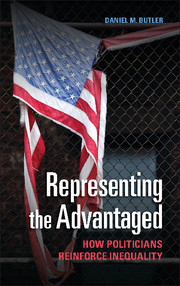Book contents
- Frontmatter
- Contents
- Acknowledgments
- 1 Representatives as the Source of Bias
- 2 When Can Representation Break Down?
- 3 Details of the Constituency Service Field Experiments
- 4 Bias in the Way Officials Process Constituents’ Opinions
- 5 Information Costs and Officials’ Proactive Effort Levels
- 6 Direct Discrimination
- 7 Bias in Politics
- References
- Index
3 - Details of the Constituency Service Field Experiments
Published online by Cambridge University Press: 05 August 2014
- Frontmatter
- Contents
- Acknowledgments
- 1 Representatives as the Source of Bias
- 2 When Can Representation Break Down?
- 3 Details of the Constituency Service Field Experiments
- 4 Bias in the Way Officials Process Constituents’ Opinions
- 5 Information Costs and Officials’ Proactive Effort Levels
- 6 Direct Discrimination
- 7 Bias in Politics
- References
- Index
Summary
In this chapter I discuss some of the common features of the constituency service field experiments that I present in Chapters 5 and 6. In my experiments I measure how public officials respond to short, simple constituency service requests that are sent via e-mail (e.g., requests for information about schools). I then measure various dimensions of the quality of the response. These experiments are of a type often referred to as an audit study. I discuss the general considerations for these audit studies because, despite their power, they are not widely used in political science. Specific details of each experiment are given in the chapter where it is used.
Experimenting on Whom?
One key feature of my experiments is that I study elites to increase the external validity of the results. The utility of experimentation depends on both its internal validity (the degree to which the experiment can identify the cause-effect relationship under investigation) and its external validity (the degree to which the findings are informative about contexts outside the experiment). The ability to randomly assign participants to treatment and control conditions helps ensure that the studies are internally valid, but it does not guarantee that the experiments are externally valid. Most experiments in political science are conducted in lab settings using paid participants, typically undergraduate students. Researchers expose these students to stimuli to try to learn how individuals outside the lab would react to similar stimuli. In most cases, lab participants likely provide a good view of how well-informed voters act in the real world. But it is less likely that such experiments can provide information about how public officials are likely to behave (Sears 1986; McDermott 2002, 2013; Butler and Kousser 2013). For my studies, I directly experiment on the offices of public officials in the conduct of their regular duties, strengthening the external validity of the results.
Information
- Type
- Chapter
- Information
- Representing the AdvantagedHow Politicians Reinforce Inequality, pp. 23 - 42Publisher: Cambridge University PressPrint publication year: 2014
